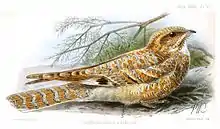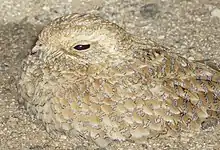Golden nightjar
The golden nightjar (Caprimulgus eximius) is a species of nightjar in the family Caprimulgidae. It is found in Sahel region in northern Sub-Saharan Africa.
| Golden nightjar | |
|---|---|
 | |
| Scientific classification | |
| Domain: | Eukaryota |
| Kingdom: | Animalia |
| Phylum: | Chordata |
| Clade: | Dinosauria |
| Class: | Aves |
| Clade: | Strisores |
| Order: | Caprimulgiformes |
| Family: | Caprimulgidae |
| Genus: | Caprimulgus |
| Species: | C. eximius |
| Binomial name | |
| Caprimulgus eximius | |
Description
The golden nightjar is a distinctively coloured, smallish nightjar which measures 23–25 cm in length. When at rest the golden nightjar appears large headed and the upperparts and wing coverts are tawny buff marked with greyish-white, dark brown edged and speckled, square shaped spots. It has a large whitish patch on its throat, the upper breast is similarly marked to the upperparts but this fades towards the unmarked tawny-buff lower breast and belly. In flight it shows a large white spot towards the tips of the wings and in poor light it appears very pale. Both sexes are alike.[3]
Voice
The Golden nightjar's song is low pitched churr which may last quite a long time and is delivered at dawn and dusk from the ground.[3]
Distribution

The golden nightjar occurs from northern Senegal and Mauritania in the west eastwards to Sudan.[3] In 2015 a female golden nightjar was seen and it, or another, was later found dead in southern Western Sahara and in 2016 a number of birds were noted in the same area suggesting that it may host a breeding population. In 2019, the breeding of the species in the area was confirmed.[4] These were the first records of this species in the Palearctic.
Habitat
The golden nightjar occurs in arid steppes and semi-desert, also on rock, gravelly or stony terrain with clumps of vegetation. It avoids dense scrub or woodland.[3]
Habits
The golden nightjar is active at dawn and dusk and through the night, roosting on the ground during the day and tending to shuffle out of the way of approaching animals rather than flushing. It has been recorded feeding over waterbodies at dusk, its diet is made up of larger insects. The normal clutch is 2 eggs which lare laid on the ground, usually near a clump of vegetation. Egg laying has been recorded in April–May in the west and March–April in Sudan.[3]
References
- BirdLife International (2016). "Caprimulgus eximius". IUCN Red List of Threatened Species. 2016: e.T22689916A93252698. doi:10.2305/IUCN.UK.2016-3.RLTS.T22689916A93252698.en. Retrieved 11 November 2021.
- "Caprimulgus eximius Temminck, 1826". Integrated Taxonomic Information System (ITIS) (https://www.itis.gov). Retrieved 2016-11-16.
- Nigel Cleere; Dave Nurney (1998). Nightjars A Guide to Nightjars and Related Nightbirds. Pica Press. pp. 246–247. ISBN 1-873403-48-8.
- "Breeding of Golden Nightjar in Western Sahara confirmed". MaghrebOrnitho. Retrieved 2019-04-22.
